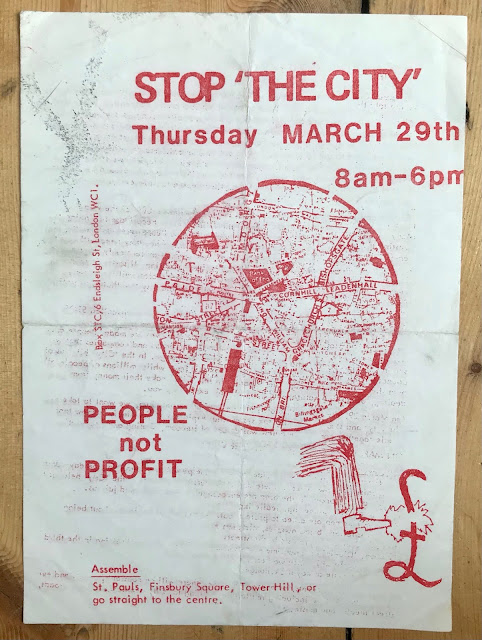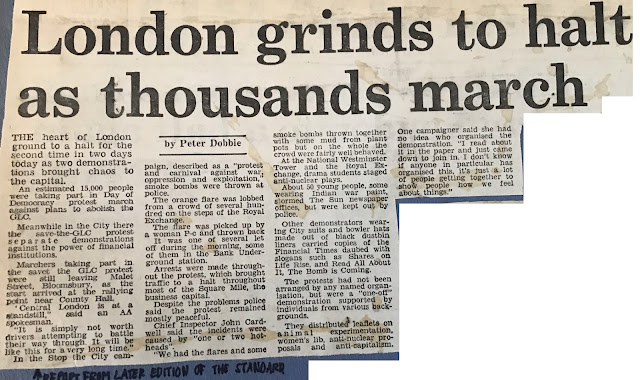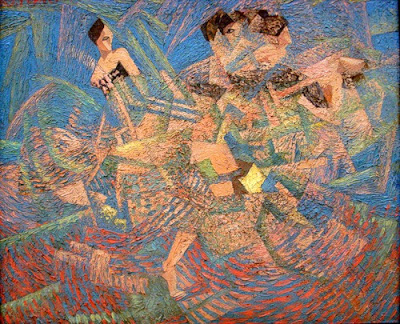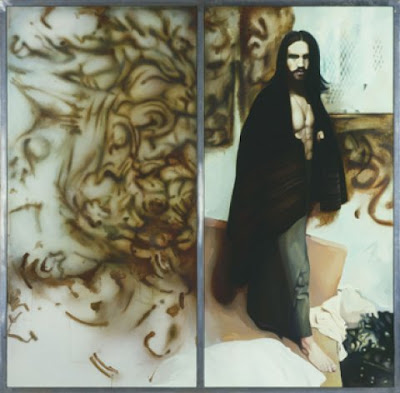 |
| 'Protest and Carnival against War, Oppression and Exploitation' |
In 1983-84 the financial centre of London was the focus for a series of one day Stop the City protests. The first of these took place in September 1983 and was followed by a bigger one in March 1984. The protest in September 1984 was also substantial, but by then the police had got wise to the tactic and were more successful at imposing control through mass arrests. I took part in both of the 1984 events.
Stop the City was defined as a 'protest and carnival against war, oppression and exploitation'. There was no single organisation behind the actions, though London Greenpeace (an anarchist group distinct from the national environmental organisation) helped initiate it. The idea was that people would plan their own actions within the overall Stop the City framework. Stop the City wasn’t simply a punk protest. It also drew its energy from the radical fringes of the peace and animal rights movements and from the broader anarchist scene, as well as from some veterans of the earlier free festival counter culture. But it was through the anarcho-punk scene that a lot of the information circulated about Stop the City, and through which many people came together to organise themselves to get to London from all over the country.
What made Stop the City so exciting was this it didn’t play by the rules. There was no march along a prearranged route negotiated in advance with the police. No permission was asked for - instead people were invited to turn up and use their own creativity and imagination. In March 1984 a combination of numbers and innovative tactics gave the protesters the upper hand for much of the day. Rather than get caught up in ritual set piece confrontations with the police, there was endless movement with groups heading off in all directions and no direction, blocking traffic and forcing the police to spread themselves thinly. There was a tangible sense of power - it was the first time I had seen people de-arrested. Coming down Change Alley we came across some isolated cops trying to make arrests, but they were quickly surrounded by a big crowd and let people go. Instead of hanging around a load of us just ran off and found ourselves on London Bridge where we blocked the traffic until a lorry decided to call our bluff and drive straight towards us. Somebody kicked a Bentley or some other luxury car stuck in the traffic.
There was anti-nuclear street theatre, and people in City suits and bowler hats made out of bin liners carrying copies of the Financial Times with slogans written on them like “Read all about it- the bomb is coming” (actually courtesy of the IRA the bomb was coming to the city, but that was a few years later, and probably not what people had in mind). By the end of the day, the police were more in less back in control. Nearly 400 people had been arrested and many of the remainder were stuck in front of the Royal Exchange building surrounded by cops - nobody called it 'kettling' then, but that was what it amounted to.
 |
| 'Stop the City - People not Profit' |
The following report of Stop the City on March 29th 1984 comes from the anarchist paper Freedom, published in May 1984:

'Stop the City (Freedom, May 1984)
'For your future, for our future, STOP NOW’ (Anon)
'The City is the place where your money from taxes, savings and pension funds is invested, and you have no control over them’ (Islington Action Group)
'We believe it's time to put a stop to the suffering of millions of people around the world, suffering created by the same economic system that runs our lives. The City of London is at the heart of all this, it is the logical place for our protest’ (Leicester Green Affinity Group)
‘Women not only serve the boss at work, they also serve their husbands and children at home as cooks and cleaners. Not only do women work harder, we get no pay for half the work [housework]’ (Stop the City Women's Group)
‘What we are trying to do is point out the grim reality that lies behind the mask of normal daily life’ (Grays Anarchist Group)
‘Ten ways to wreck the micro-computer in your office:- 1. Pour coffee ( with salt instead of sugar in it) into the keyboard to gum up the works...’ (Free London)
‘Dear fellow commuter,...on an average commuter train, about 20 people are directly involved with producing goods for military use’ (anon)
‘What's going on? As you walk through the City area today you may see quite a few people involved in various forms of action aimed at exposing the nature of London's financial district. Do not be afraid of these people, they could be your friends... As we listen to EMI records, people in foreign lands listen to EMI weapons guidance systems... People need each other, not money!’ (anon)
‘We are claimants, and as claimants we are forced to live in misery and poverty because of the decisions made behind the doors of these institutions. It's not jobs we demand...but the right to a decent life for everyone.’ (Claimants Action Nottingham)
‘In countries where people used to grow their own food, they are now paid minimal wages to produce non-edible cash crops for western companies... if dissatisfaction with this system causes social unrest, the west sells the same countries arms with which to restore law and order. ’ (LSE CND)
'I am here today because... I want everyone in the world to be happy... because they are stealing my life away and selling it back at a profit... because a terrified animal dies unnecessarily every 6 seconds... because everything has been appropriated and we want it back... because they are giving the children guns and violence and destroying their innocence... ’ (Mike, Brambles Farm Peace Camp)
‘Look at this fucking world, it's not ours no more. It belongs to rich fascist scum who, unless they are stopped, are gonna blow it to shit. The time has come to stop holding back... No longer will we march ‘peacefully’ to Hyde Park. It’s banks what fund war, not parks!’ (Paul)
‘I, the Commissioner of Police for the City of London, by virtue of the powers conferred upon me by Section 22 of the City of London Police Act, 1839, as amended by Section 8 of the City of London (Various Powers) Act, 1956 for the purpose of keeping order order and preventing obstruction of the thoroughfares in the immediate neighbourhood of the Mansion House and Guildhall of the said City, the Royal Exchange, the Bank of England, the General Post Office and other places of public resort within the said City and liberties on the 29th March, 1984… hereby direct Constables on the on the 29th March, 1984 in the said thoroughfares:
1. To prevent the gathering together of persons within a group.
2. To disperse any group of persons which may gather together.
3. To direct any person found loitering to move.
4. To prevent any procession.
5. To prevent the deposit or any refuse, litter or other object.
6. To secure the removal of any refuse, litter or other object by the person the Constable has reason to believe is responsible for the deposit thereof.
7. To prevent the making of any unnecessary noise which the Constable has reason to believe causes, or contributes towards, disturbance of the peace.
Dated this 26th a day March 1984, The Commissioner of Police for the City of London'
'You failed totally!' (STC)
Last September, after 6 months of discussions and preparations around the country growing out of the actions against military bases, about 1,500 people came to Stop the City of London in protest against wars and arms trade profits. The success of that day in terms of communicating to workers, disrupting business, and creating a determined and festive event encouraged many others to join in preparations for another protest — on the day profits for the whole year were symbolically to be counted up - March 29th 1984.
Having been in the City, seen how it works, how all companies and banks are interlinked, it was decided this time to make a general protest against the profit system. This would be a chance for everyone involved in trying to change things - opposing the exploitation of women, of nature, of animals, opposing wars, repression and poverty, and the power of money over us - to come together on this appropriate day and challenge the financial heart of the country.
As a network grew, everyone encouraged each other to create the kind of day they wished, to protest about the things they felt most strongly about and in the way they wanted. A truly decentralised yet well co-ordinated attempt to Stop the City and reclaim it for people.
The week before, on March 22nd, there were local protests in financial centres of 7 or 8 towns with pickets, occupations, leafleting, graffiti, processions and music.
On the 29th, up to 3,000 people took part together in London and this is an attempt to get down on paper some of the amazing and diverse activities...
Stopping the City
7 - 8am, First Aid, creche and assembly points set up. Police divert all lorries from City. 30 cyclists set off to do a very slow tour of the streets and stop the traffic. Balcony of arms trading company in Holborn occupied by London Peace Action, banners and balloons.
8 - 9am, Green CND protests at Electricity Board HQ all day. St Paul's packed already, many go to Bank area. People try to block roads. March down Cannon Street, Threadneedle Street blocked. Radio reports. People at Stock Exchange forced to move on. Women's action at Bank of England to protest about unpaid domestic exploitation foiled by police — continue to leaflet nearby. Many groups all over City, leafleting, dressed up, with placards, puppets, games, etc.
9 - 10am, 500 people at Royal Exchange. Police try to split people up. Leafleting and smoke flare in Bank tube station. 150 people disrupt Leadenhall meat market against animal exploitation. People continue to assemble at Bank - up to 1,000 - police try to block everyone in and keep traffic moving. Hundreds of cars begin to be quietly immobilised in car parks (all day). Free vegan food distributed for hours at St Paul's. Many locks glued up throughout the day.
10 – 11 am, The crowd who’d taken over the front of the Royal Exchange resist police efforts to force people out, wooden barrier collapses. People then hemmed in, police using horses. Lots of noise. Everywhere workers look from windows. Group go to do Fleet Street action — too many police. Spirits still high everywhere despite police violence. Lots of graffiti. Anti-nuclear street theatre at Nat West Tower. People enter banks to open and close accounts. A couple of groups walk back and forth over zebra crossings.
11 – 12 am, American, Russian and British flags burned at Bank. 3-400 march around fur trade area. 100 people break out of police cordon at Royal Exchange and attack windows of financial institutions — Barclays, Navigation House, Nat West and 30 other places. Car overturned as barricade and constant moving means police unable to stop action. Smoke flares, paint thrown etc. Securicor van too heavy to turn over, Roll Royce which tries to run someone over is wrecked. Still hundreds at St Paul's, and others running excitedly around (for fun!). Leafleting at Bank tube station continues.
12 - 1pm, Anti-apartheid picket of Barclays forced to move, so visit nearby branches. Jugglers, singers, puppeteers also threatened and police try to clear Bank again. Traffic blocked. Quiet for a while. A group take 2,000 leaflets to Greater London Council ‘democracy day’ march. Evening Standard quotes police as being ‘worried about possible link-up’. Creche going well (8 kids). Our own legal back-up people begin to get busy. 30 people ‘die-in’ on roads at St Paul's. Cacophony of noise everywhere on the hour. Some of large crowd on steps of Mansion House resist mass arrests. Statues, especially military ones, ‘decorated’.
1 – 2 pm, Claimants group burn UB40 identity cards at Bank. 30 women visit Fleet Street, raid Boots the Chemist and throw tampons in the street to protest at their ‘luxury item’ VAT classification. Protest outside the Sun also. People again break free from police cordon at Bank, resist their violence and damage bank property – Norwich Union, Leeds Permanent and American International. Spikes to stop traffic thrown in road.
2- 3 pm, More rumpus on the hour! 20 cyclists again stop traffic. Mobile carnival stage, with live bands and people following almost reaches Bank from Tower Hill, but seized by police. Over 200 people held in police cells continue their protest and have fun by making noise and causing floods etc. Nat West Tower entered, files ripped up, fire alarms set off. Police bike knocked over. Groups of ‘nuns’ and Stockbrokers’ still leafleting. St Paul's - face painting, and also ‘God is Dead!' charge into cathedral. Musical and noisy processions round Royal Exchange. Orange smoke flare set off – thrown back by policewoman who hits another cop. 200 people go to Guildhall but driven back by police – court opened but no-one brought to appear so closes again (later we discover that Princess Alexandra was due to visit at 6pm)
3 - 4 pm, 200 people make human barricade across London Bridge. Traffic stop until police arrive. People begin to congregate at Bank again, spilling into streets all around. Lots of chanting, angry and good humoured at same time! Still many hemmed in. Still groups of singers and leafleters walking around.
4 - 5 pm, 1,500 at Bank. Surges into the street and back. London clearing bank window smashed as movement of crucial ‘City’ cheques is disrupted. Stockbrokers’ messages fouled up. Thousands of workers begin to go home, many watch with interest and amusement what is going on, as at lunchtime. 350 prisoners held in cells, and up to 200 in police vans. Incredibly, despite police violence people still good humoured, but gradually getting worn out.
5 - 6 pm, People hemmed in, but relax, and gradually everyone disperses. 3-400 go to block Whitehall and Ministry of Defence in Central London as protest against Cruise missile convoy movements during previous night and in solidarity with women of Greenham who had blocked its path on the motorway.
It's impossible to do justice to everyone’s activities. Throughout the day many people were also hanging around, taking photos or watching. For some, this was the first experience of a self-organised protest and so they were unsure of what to do, the need, to come prepared, take initiatives, talk to others, etc. Also many were angry yet intimidated by police violence. But also loads of people wanted to join in and kept asking ‘what's happening?', ‘where's the action?', and so on. Some came for just an hour or two to show support. Everyone made a contribution in their own way.
What were the achievements?
Well, it was certainly a day people in the City will remember. The machinery of oppression thrives on appearing invincible, unquestioned and eternal, and our protests have begun slowly to break this spell. All day workers looked from windows, stood in doorways and on balconies, or walked unhurriedly about. No-one seemed threatened, some were prejudiced yet many more seemed excited, thoughtful, amused or provoked to think and discuss with colleagues what was happening and why. Some were surprised and angry at police violence which partly aimed to keep workers and protesters apart.
I collected leaflets being distributed by 31 different groups, a dazzling range of opinions and ideas —complemented by graffiti. But there were still many working there who didn't understand or feel involved. Likewise, many of us benefited from trying to talk to and understand the people there, their attitudes to work, difficulty in challenging their roles and employers.
As for actually disrupting business — while we were there we certainly had some effect. We enticed people away from their jobs and towards the human community in their midst. Traffic, mostly on business, was often stopped or slowed up all day. The front doors of some buildings were closed, some were picketed and those around Bank disrupted for hours. And don't forget that some phone lines were blocked by those contributing from home or work to the phone blockade.
On two or three occasions, largish groups of people managed to directly damage property of financial institutions, both as a statement of anger and also to make them pay a little for a change. And perhaps the most significant disruption was of the movement of cheques at the end of the day when millions of pounds physically circulates around the area. According to the Times, ‘The banking community struggled to keep money flows moving, despite the unrest. They succeeded - but only just’. ‘Bank balances were £11million below target overnight’.
The aim of creating a festive, human atmosphere was partially successful, despite everything the police did. There was lots of music and noise, clowning, puppets and banners, painted faces, joking and openly expressing our energy and humanity. There was a great deal of solidarity, warmth and respect amongst ourselves despite being strangers and of many differing ideas and groups. This is so important and is a strength which will attract others to think about what we're saying and doing.
Likewise, the fact that there were no leaders or formal structures, just so many people with initiative, energy and determination to do their best. It is also encouraging to read the 17-page police briefing (which fell out of a back pocket on the day) now widely distributed, to see what their aims were for the 29th. They took the protest very seriously, cancelled all leave in the City force, and all coppers worked at least 12 hours continuously. With the miners strike and blockades, other large demonstrations and Greenham blocking of roads near London, they were at full stretch. London Transport police and even ‘special constabulary’ were brought in. Special powers (1839) for the City were enacted. They clearly understood the aims of the protest, and the range of events that had been planned and publicised. And they made all sorts of-preparations. However, despite their plans, 450 arrests and other violence, they failed.
We showed that we have the determination and the strength, initiative and imagination to make a telling protest, and that if people everywhere only realised their strength, the power of the state could be effectively challenged on a wide scale.
Involving more people
But if we are to learn from our struggles, we have also to look at and overcome our limitations. Most of the people who took part are active in anti-militarist, animal liberation or general libertarian groups, or a part of the large dissatisfied urban unemployed sub-culture...
Yet it was difficult to involve those who went on strike on the same day to defend public services and the GLC, and also striking miners. Likewise, the vast majority of people who feel strongly about some aspects of what's wrong with the world, still think that joining an organisation (like CND, War on Want, RSPCA or whatever) or voting for the Labour party is the thing to do. Many others would also like a better world but don't believe people can change things, or are afraid to express their feelings. lt is all these people who need to get together to begin to move against the system.
And there are yet millions more, billions world-wide, working class people who have to struggle where they live and work just to survive, to maintain self-respect. Many don't relate to political parties or endless protests, yet we need everyone to begin to really stop the systematic industrial destruction and exploitation of our world.
The Stop the City demonstration is one small yet significant step in a developing process of awakening and of real opposition. We are learning as we take part. Many more people have become involved, not only in large scale protests but also in everyday activities, overcoming isolation and gaining confidence. Changing society is not only about collective opposition, it is also about people creating and extending mutual aid, solidarity and libertarian relationships amongst each other — neighbours, work-mates and wherever people meet. If the Stop the City idea contributes to that and to the creation of diverse local initiatives and resistance, it will be worthwhile.
What now?
On the 14th and 15th of April there was a follow-up weekend. On Saturday 60-70 people, many having been arrested, came to discuss court procedures, solidarity, films, look at photos, etc. Anyone who wishes to support those arrested can come to Guildhall Magistrates Court on Friday 11th and 25th May, 10:00am, or send donations to the Bust Fund Network, c/o Housmans, 5 Caledonian Road,London N1. Any other legal enquiries, phone Amanda 01-833 1633. An exciting unedited film was shown and is being turned into a film/video to be made available. Contact Mick 01-278 0075 if you have any additional material.
The second day was a general discussion about stopping the Cityy, what happened and the future. There was a very constructive and respectful atmosphere, and a general feeling that we had achieved a lot and there was so much more that was possible - not just in the City but everywhere. There will be a week of of protest against financial institutions, and the wars, exploitation and destruction they cause and profit from on September 22nd- 29th, with a general call to Stop the City, Thursday September 27th again. Everyone in the world is invited!
Likewise it was decided to Stop the City on Thursday May 31st also, while the enthusiasm and memories of March are alive. A totally self-organised protest – there won’t be any co-ordination meetings for May 31st, so everyone is encouraged to spread the word, come prepared and do what they think best.
TOGETHER WE CAN CHANGE OUR WORLD'.


Report from The Standard, 29 March 1983
'policewoman throws back smoke bomb as demo brings violence to the city'
'London grinds to a halt as thousands march'
(on the same day as Stop the City thousands took part in a march against plans to abolish the Greater London Council)
 |
| A Lambeth Stop the City planning meeting at 121 Railton Road in March 1984 |
These photos are from an incredible collection of photos posted on Flickr from the Rio Tape Slide Newsreel Group Archive, from a 1980s photography project based at the Rio Cinema
Other related History is Made at Night posts:
- J18 Carnival Against Capital, 1999
See also Richard Metzgers' memories and photographs of this day at Dangerous Minds.
[post originally written in 2011 as the Occupy Stock Exchange London protest camped out by St Paul's in the same area targeted by Stop the City. Updated September 2023 with flyers and press cuttings. Updated 1 December 2024 with Rio photos]
























































